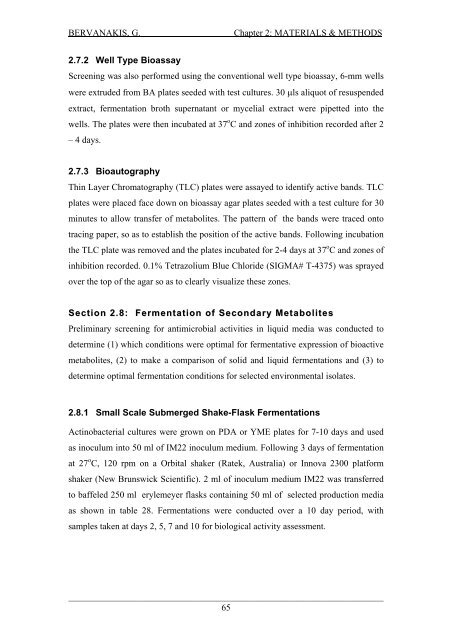Detection and Expression of Biosynthetic Genes in Actinobacteria ...
Detection and Expression of Biosynthetic Genes in Actinobacteria ...
Detection and Expression of Biosynthetic Genes in Actinobacteria ...
Create successful ePaper yourself
Turn your PDF publications into a flip-book with our unique Google optimized e-Paper software.
BERVANAKIS, G.Chapter 2: MATERIALS & METHODS2.7.2 Well Type BioassayScreen<strong>in</strong>g was also performed us<strong>in</strong>g the conventional well type bioassay, 6-mm wellswere extruded from BA plates seeded with test cultures. 30 μls aliquot <strong>of</strong> resuspendedextract, fermentation broth supernatant or mycelial extract were pipetted <strong>in</strong>to thewells. The plates were then <strong>in</strong>cubated at 37 o C <strong>and</strong> zones <strong>of</strong> <strong>in</strong>hibition recorded after 2– 4 days.2.7.3 BioautographyTh<strong>in</strong> Layer Chromatography (TLC) plates were assayed to identify active b<strong>and</strong>s. TLCplates were placed face down on bioassay agar plates seeded with a test culture for 30m<strong>in</strong>utes to allow transfer <strong>of</strong> metabolites. The pattern <strong>of</strong> the b<strong>and</strong>s were traced ontotrac<strong>in</strong>g paper, so as to establish the position <strong>of</strong> the active b<strong>and</strong>s. Follow<strong>in</strong>g <strong>in</strong>cubationthe TLC plate was removed <strong>and</strong> the plates <strong>in</strong>cubated for 2-4 days at 37 o C <strong>and</strong> zones <strong>of</strong><strong>in</strong>hibition recorded. 0.1% Tetrazolium Blue Chloride (SIGMA# T-4375) was sprayedover the top <strong>of</strong> the agar so as to clearly visualize these zones.Section 2.8: Fermentation <strong>of</strong> Secondary MetabolitesPrelim<strong>in</strong>ary screen<strong>in</strong>g for antimicrobial activities <strong>in</strong> liquid media was conducted todeterm<strong>in</strong>e (1) which conditions were optimal for fermentative expression <strong>of</strong> bioactivemetabolites, (2) to make a comparison <strong>of</strong> solid <strong>and</strong> liquid fermentations <strong>and</strong> (3) todeterm<strong>in</strong>e optimal fermentation conditions for selected environmental isolates.2.8.1 Small Scale Submerged Shake-Flask FermentationsAct<strong>in</strong>obacterial cultures were grown on PDA or YME plates for 7-10 days <strong>and</strong> usedas <strong>in</strong>oculum <strong>in</strong>to 50 ml <strong>of</strong> IM22 <strong>in</strong>oculum medium. Follow<strong>in</strong>g 3 days <strong>of</strong> fermentationat 27 o C, 120 rpm on a Orbital shaker (Ratek, Australia) or Innova 2300 platformshaker (New Brunswick Scientific). 2 ml <strong>of</strong> <strong>in</strong>oculum medium IM22 was transferredto baffeled 250 ml erylemeyer flasks conta<strong>in</strong><strong>in</strong>g 50 ml <strong>of</strong> selected production mediaas shown <strong>in</strong> table 28. Fermentations were conducted over a 10 day period, withsamples taken at days 2, 5, 7 <strong>and</strong> 10 for biological activity assessment.___________________________________________________________________________________65















